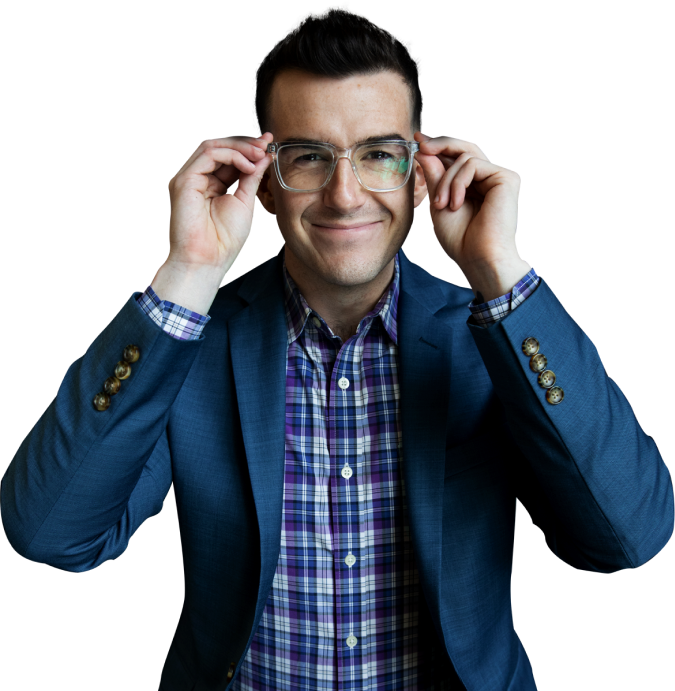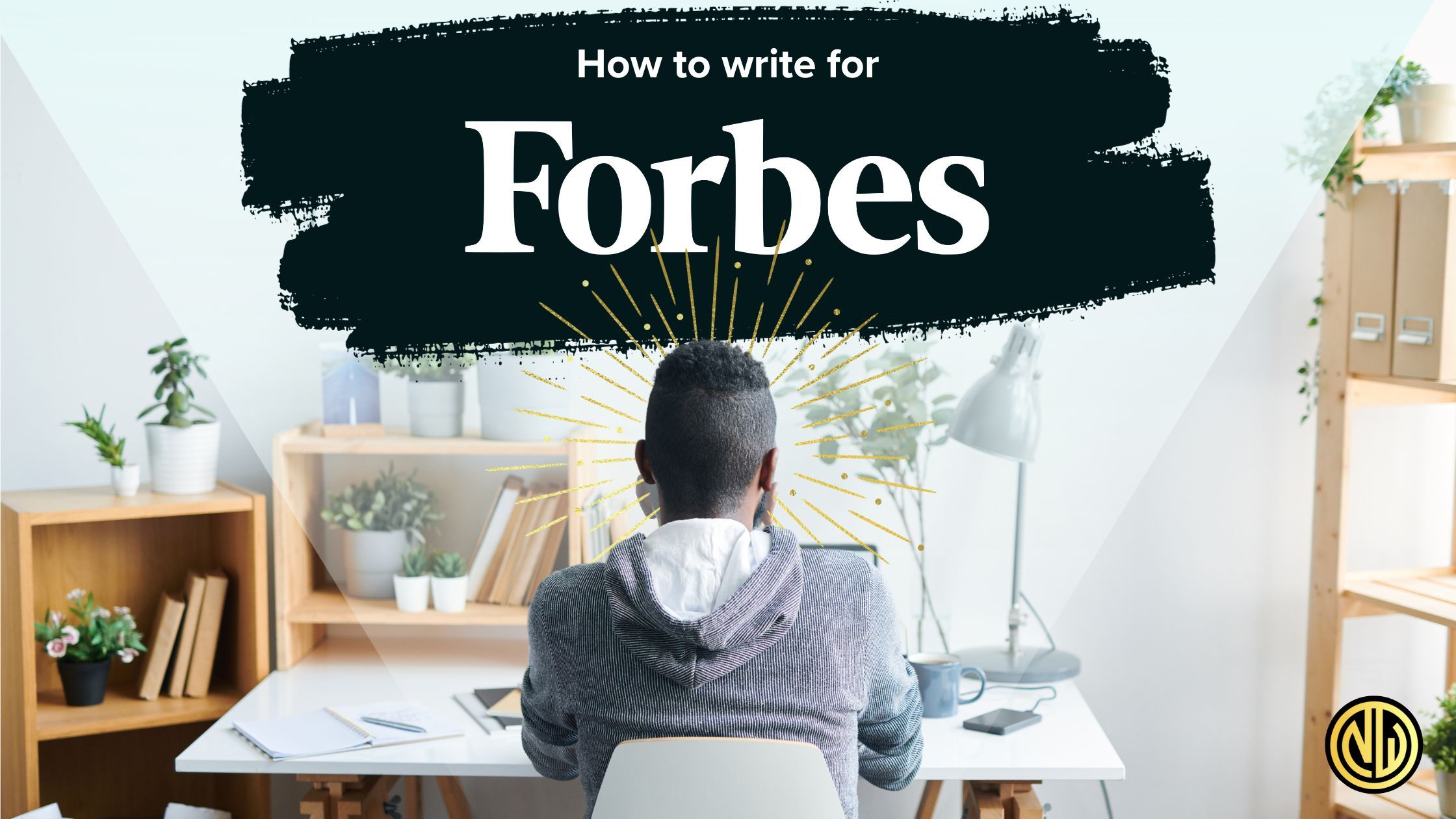Forbes is one of the most popular online publications for professionals who want to use articles to grow their personal brand. And I'm happy to report that this blog post still works.
When a reader reached out to me last fall after reading this exact blog post, I admit I didn't have any extra helping hands or strings to pull. But using the information below, she was able to land a contributor column in Forbes, a helpful platform to complement her other professional credentials.
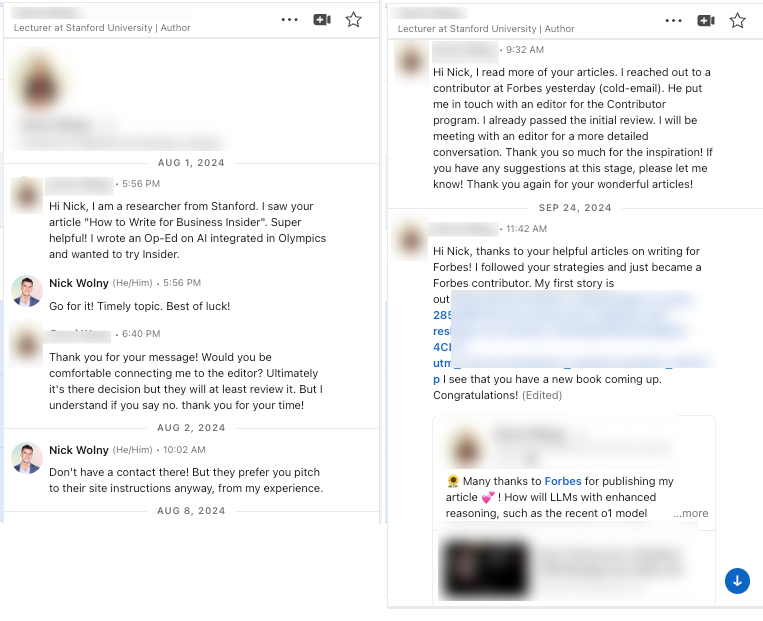
When Forbes first introduced its contributing writer platform in 2010, it was an innovative strategy in the digital news industry. Qualified (and sometimes not-so-qualified) thought leaders could write and publish articles on Forbes' site for their respective areas of expertise. This model was win/win: Forbes got more content, and individuals had a byline they could use as a credibility marker.
However, this approach has also courted controversy, especially in recent years. The headline of a 2022 article by Joshua Benton for Nieman Lab says it all: “An incomplete history of Forbes.com as a platform for scams, grift, and bad journalism.” Yikes.
Contributors began accepting payment in exchange for covering brands, which is a no-no, and at one point it got so bad you had schemers selling Forbes placements on Fiverr. That’s how powerful and intoxicating the Forbes brand is.
Key Takeaways
- The contributor strategy allowed Forbes to farm story ideas and increase its digital footprint quickly.
- The strategy paid off: by 2012, Forbes’ website traffic had doubled to 30 million visitors a month, powered by nearly a thousand post authors, according to Poynter, a global leader in journalism and fact-based reporting.
- By 2019, 3,000 contributors were pumping out 8,000 posts a month.
- Contributors were compensated, but multiple sources say this pay was a few hundred dollars a month at best.
The media juggernaut has worked hard to reign things in. And if you understand how to pitch, there are still opportunities to become a contributor. Here’s what to know about how to write for Forbes.
Types of Writers at Forbes
Forbes has a large team of editors and reporters, as well as contributors, who write guest posts. If you’re pitching the online publication, the type of writer you are will depend on the types of stories you want to pitch.
You’ll most likely either be pitching a profile, a paid assignment or a contributor column.
Profiles
A profile is when a reporter interviews you and does a story on you.
Profiles are written by someone else, not you. But a feature profile can be a powerful credibility marker. If you have an amazing story that relates to money or entrepreneurship, professional journalists at Forbes might be interested in covering you for a story.
These stories are valuable when you're trying to land certain notability markers online, such as a Wikipedia page. Since someone else wrote the piece, a feature profile projects notoriety and credibility in ways that writing the story yourself simple cannot.

Some of you want a profile, not a column or guest post, for personal branding reasons, which is fine. If this is the case, focus more on how to pitch your story to existing writers instead.
Paid Assignments
In contrast, a paid assignment is when journalists or freelance writers pitch an editor directly, then are paid to do exclusive reporting as a Forbes writer.
In a paid assignment, you are not the main character in your story. Your subjects are. If you’re looking to make money writing for Forbes, paid assignments are the way to do it, but they may not be the best way to create or project thought leadership, since your articles won't be about you or your POV.
Contributor Columns
Finally, you have contributor columns. When you pitch to be a contributor, you are pitching a one-off story or series in which you plan to write about a specific industry or topic. These articles can be explanatory essays, opinion editorials or a mix or both.
If pitching a column or multiple stories, your pitch should include:
- The vision and purpose of your column.
- What topics you plan on covering.
- Why the topic should be written about now.
- A few story ideas.
If you have past samples of writing, include links to those posts as well.
Editor Tip:It's rare to land a column right out of the gate. The more common path is to pitch one-off articles, get good traction with an editor, and then pitch a recurring series.
Similar to pitching columns to other business sites such as Fast Company, Huffington Post or Business Insider, your pitch itself needs to showcase writing potential. Pitches for Forbes submissions can show off any or all of the following credibility markers:
- Polished writing.
- Story ideas that relate to career development, personal finance or small business growth.
- Fun and memorable anecdotes and practical inspiration.
- Coverage on other authority websites or media outlets.
- A brief bio that includes your compelling personal story, established business success or some other opportunity for personal connection.
Contributors at Forbes log into a content management system (CMS), much like other brands that have similar contributor programs, and can publish as little or as often as they like.
This is one reason why you see some contributors posting often, whereas others seemingly haven’t posted in months.
Alert:You cannot accept payment to feature sources in media articles, whether they be contributed posts or freelance writing. It's a conflict of interest from a sourcing perspective.
What Is a ‘Forbes Council’, and Is It the Same as Being a Forbes Contributor?
The Forbes Councils are a series of pay-to-play membership programs. More information about the Councils and the application are here. When you apply to a Forbes Council, you pay a substantial membership fee.
Tip:The Forbes Councils are a separate media entity from Forbes, though both carry the Forbes brand name.
Forbes Council members are not contributors. And in fact, if you apply for and join a Forbes Council, you can never contribute to Forbes as a regular contributor, per their terms and conditions. Some aspiring entrepreneur-contributors had no idea this was the case, and say they would have pitched themselves as contributors instead had they known these terms and conditions.
The Forbes Council is a separate product from Forbes, and if you enroll in it you disqualify yourself from ever becoming a full contributor.
Keep your eyes peeled in coming months to see if brands like Huffington Post, Business Insider, Fast Company or the South China Morning Post introduce a council-like program. If they do, read the fine print.
Whenever possible, we want to earn coverage through merit, rather than buy our way in. Aim for the Forbes contributor program.
Related: How to Become a Business Insider Contributor
What Forbes Contributors Cover
While Forbes has long been a prestige American business brand, the website’s contributor access has allowed it to scale and diversify into different topics. This brand is big, y’all.
Generally, most columns and articles will relate in some way to one or more of the following beats:
- Business.
- Money.
- Leadership.
- Innovation.
- Entrepreneurship.
- Real estate.
- Digital marketing.
- Policy.
- Technology.
- Travel.
To a lesser extent, you might also see a blog post or completed on lifestyle, health, and culture.
If your article idea falls into one of those buckets — and your pitch is both fresh and compelling — writing for Forbes might be a perfect fit. Here’s a four-step strategy to keep in mind before taking your best shot.
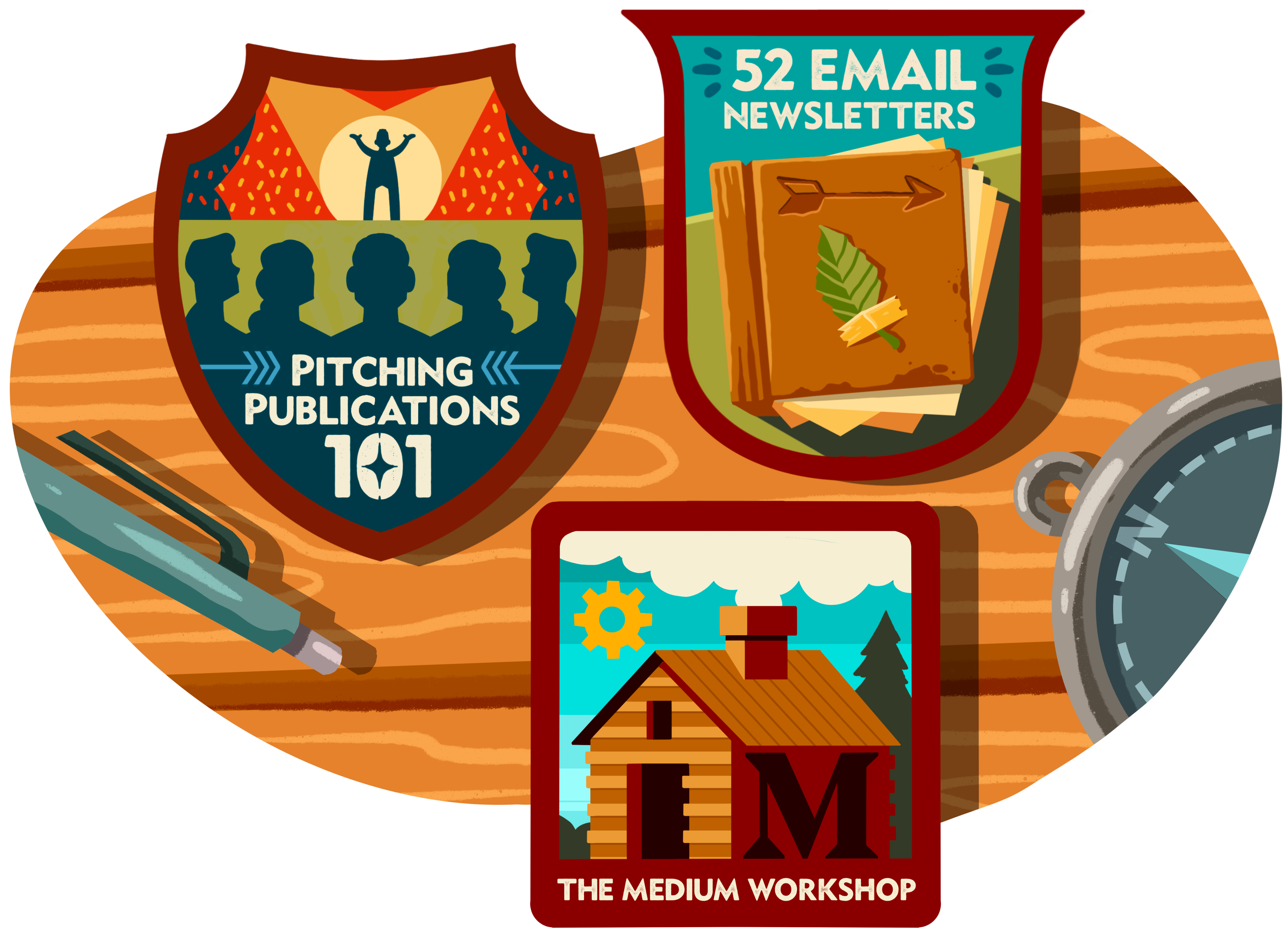
Learn How to Pitch Forbes and Others
Stress less, pitch more. Get the ‘Pitching Publications 101’ Workshop and two other resources for $57 USD as part of the Camp Wordsmith® Sneak Peek Bundle.
How to Write for Forbes in 4 Steps
Step 1: Read the Outlet
Take it from me, an editor: It is immediately obvious in a pitch whether or not someone has actually read anything on the publication’s website before.
Reading an outlet will both help you get a sense of the target publication's writing style and inform your next blog post or story idea. Before submitting an article to Forbes opinion, visit the website frequently, and follow the brand on social media.
If it’s in your budget, consider subscribing to the outlet as well.
Step 2: Research the Relevant Editor
Forbes has a lot of bylines on its site, and while it may be helpful for contributors to know who you are for profile opportunities, your gatekeeper for freelance writing or contributor column aspirations will almost always be an editor. Look specifically for the editors, people who are employed full time by Forbes, before making your next move.
You can look at site bylines to see who on Forbes is an editor, but I find it helpful to also use social media. Normally, I recommend looking for an editor’s Twitter/X account first, but since Forbes has so many brands and so many contributors, identifying a gatekeeper can be tricky.
Look at all these industry-specific Forbes accounts! 🤯
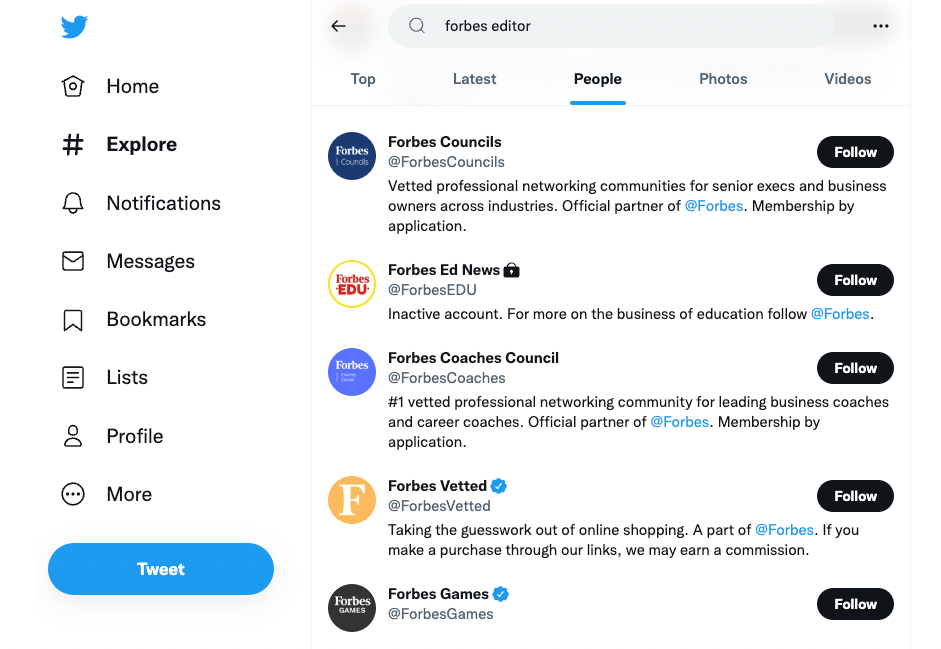
Looking on LinkedIn produces much better results in my experience. Someone with the title “contributing editor” would be an ideal target, but you’d also do well to identify assistant editors, associate editors, editors, senior editors, deputy editors, managing editors, executive editors or an editor-at-large. These positions vary depending on internal leadership structure, but they’ll all be responsible for sourcing ideas and publishing writers’ articles.
Don’t pitch an editor-in-chief unless it’s a small brand. They’re usually too busy with other leadership or P&L responsibilities.
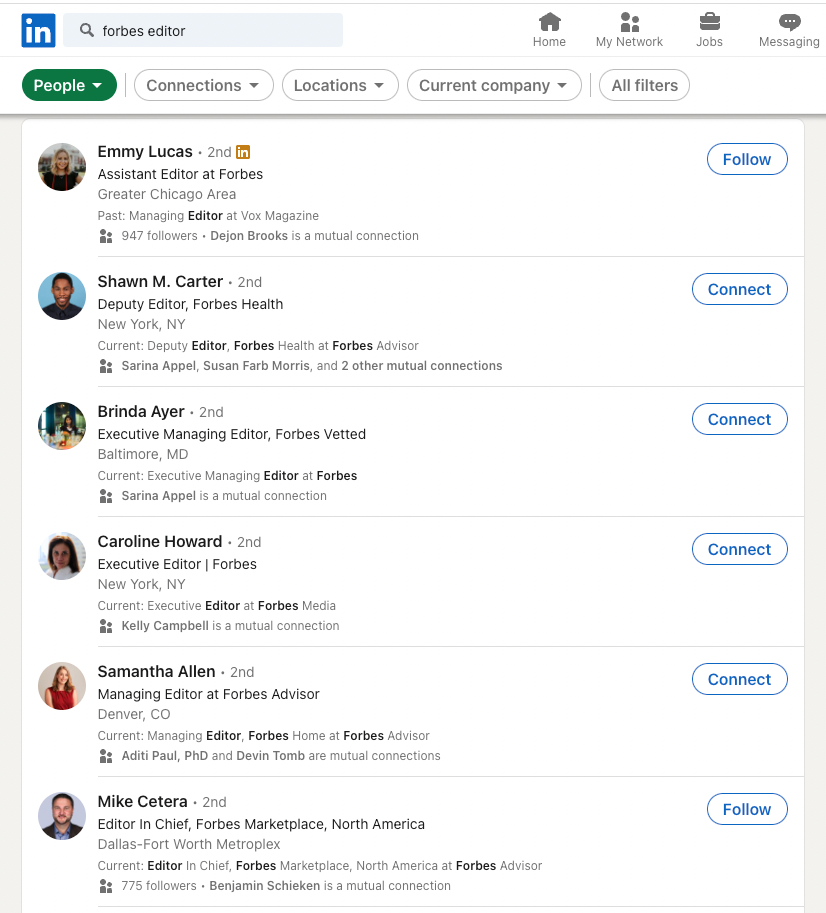
Once you have relevant editor leads, do a search on Google or another search engine to see what you can find. In these examples, I identified that Emmy Lucas oversaw coverage for the communities and leadership vertical, whereas Shawn Carter oversaw coverage in the health vertical.
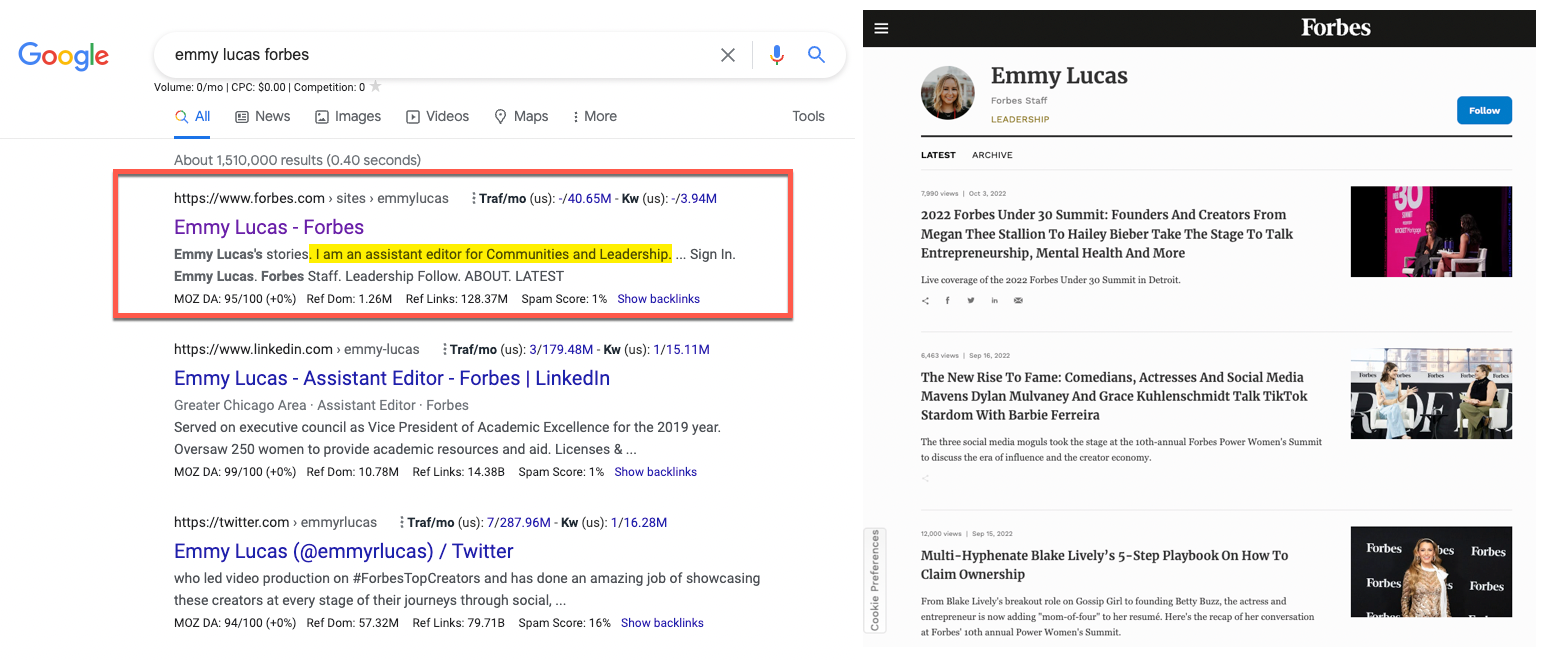

If the editor has articles published, you can look through them, but remember that not all editors write articles.
Editor Tip:Some editors double as writers for an outlet, whereas others don't. Still prioritize pitching an editor when you can.
Pitching an editor via email is considered standard etiquette in online media. If you need to locate an editor’s email address, do a search on it first; some editors list their email address and other basic information publicly for transparency.
If you don’t find anything, consider using an email scraper. This is a software that can scrape data off a website, including email addresses associated with the domain name. I liked using VoilaNorbert, which lets you do your first 50 searches for free. To use this tool effectively, you need an editor’s first and last name and the domain of the website they’re probably associated with.

I found Emmy’s email address using this tool. For Shawn, I didn’t find it at first, so I did a Google search, and found that he publicly lists his email address. It had a different domain. I retried VoilaNorbert with the updated domain, and it worked.
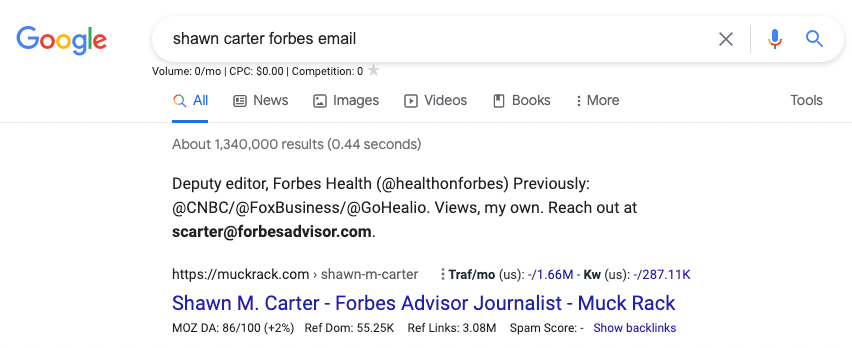

For most editors, our email addresses get leaked into various databases anyway, so it’s not a faux pas to pitch a cold email to an editor. People think that identifying the appropriate editor is the hardest part of pitching publications; it isn’t. The most important factor is that your pitch for your guest post is good!
Editor Tip:Don't pitch the editor-in-chief (EIC) at a large publication; that role is often more about leadership than management of individual articles.
Step 3: Write a Clear, Focused Pitch
Time to take your swing! There is no perfect pitch formula, but the sooner you can get to your point and make your case, the better.
Most successful pitches have at least one, if not all, of the following three components.
Relevant to the Outlet
Most pitches are stock pitches. PR agencies try to “spray and pray” many editors from many publications all at once with the same pitch (It's awful, y'all). Instead, indicate relevance right from the start.
Communicate to the editor why this pitch is specifically for them and their particular publication. Also cite recent articles or details about the outlet to signal that your pitch is custom to this editor.
Leads with the Story First and Yourself Second
Sell your story to the Forbes editor. Why does Forbes need to cover this topic? Why do they need to cover it in this way, or invite you into their blogging platform alongside other current contributors?
When writers lead with pitching themselves, they sometimes go on and on about how great they are and forget to pitch the thing that's actually for the reader: the story!
Make your pitch more about serving Forbes’ target audience.
Timeframe
Finally, communicate some details about what turnaround time would look like, and, if the article or column is timely, why it should be published now and not later. These details create a call to action, and they cut down on administrative back-and-forth.
Do not submit a completed article or final draft in your initial pitch, unless the publication explicitly requests for completed drafts. (Our editor inboxes will thank you!) Instead, get approval on your idea first before proceeding further.
Step 4: Write a Compelling, Succinct Article
Did your pitch get accepted? Well done! Now let’s ensure you back up what you pitched with a solid article draft.
Just because your pitch has been accepted doesn’t mean your article will sail through. You'll now need to deliver a quality article that demonstrates your perspective and/or writing skills.
Keep these ideas in mind.
Sourcing: Use published research, industry statistics, or original interviews with sources to land your point. Some editors don’t want contributors to conduct interviews; they want an opinion piece that cites outside data.
Brevity: In the news business, we constantly strive to communicate the details in as few words as possible. This helps with comprehension, and it’s also more inclusive. Shorter is often better.
Service: Serve your readers, not yourself. Your article can’t be a commercial, and overly sales-y articles are also looked down upon by big publications. Serve your readers by providing valuable information or insight that you, a subject matter expert, know well.
Definition: Service Journalism:Service journalism is a style of journalism popular with publications. After communicating the facts, service journalism offers readers actionable tips so they can live better lives.
An editor wants to work with a writer who balances research with personal perspective and actionable information. What should new business owners or your target audience do after they read? Make the takeaways clear.
Frequently Asked Questions
Is It Okay to Use an Email Scraper to Find an Editor’s Email Address?
Yes. Take it from me, an editor; we get pitches from all directions. It’s okay to cold pitch an editor, but to make the effort worth your while, you need a great pitch.
How Long Should my Pitch for Forbes Be?
Shorter is always better, but be sure to give enough information to make a compelling argument. You are pitching to start a discussion. Most pitches I get are one to four paragraphs in length.
Who Is the Best Editor to Pitch at Forbes?
There isn’t a best editor. But some editors will be more relevant than others, because they all oversee certain industries and/or sections of the website.
Should I Pitch an Editor via Social Media?
You can try using social media to get an editor’s attention. My perspective is that adding value to an editor by sharing their work or leaving thoughtful comments can create name familiarity that might help you later when you pitch to their inbox.
Can Anyone Write for Forbes?
You don't need professional writing credentials to become a Forbes contributor. But you do need a clear perspective drawn from expertise.
How Much Does It Cost to Write for Forbes?
Forbes contributors pay nothing to publish on the site. The Forbes Councils, a different, pay-to-play program, cost anywhere from $600 to $5,000 annually.
Take a Step Toward Writing for Forbes Today
Pitching contributed articles is a unique beast, but when you hit the bullseye, you’ll have a powerful credibility marker that will last for the life of your career.
Be patient, focus on quality, and eventually your efforts will pay off. ◆
Related Stories
How to Write an Editorial, in 6 Steps
How to Write a Lead: 9 Ways to Nail Your Opening
Inverted Pyramid: The Delicious News Writing Format That Produces Clear Stories, Every Time
How to Write For Harvard Business Review
The Anecdotal Lead: How to Captivate Readers with Quick, Short Stories
AP Style: Why We All Follow a Rulebook First Published in the 1950s – And Love It
Writing on Medium: The Ultimate Guide
